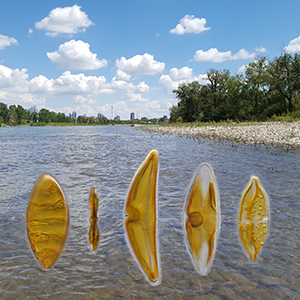Exploring diatom diversity through cultures - a case study from the Bow River, Canada

Accepted: 18 November 2022
HTML: 11
All claims expressed in this article are solely those of the authors and do not necessarily represent those of their affiliated organizations, or those of the publisher, the editors and the reviewers. Any product that may be evaluated in this article or claim that may be made by its manufacturer is not guaranteed or endorsed by the publisher.
Authors
Diatom cultures can help answer taxonomic, biogeographic and ecological questions on a local and global scale. Unialgal cultures are derived from a single cell and provide abundant material for morphological and molecular analyses. The link between the historic morphological species concept and the molecular data is becoming increasingly important with the use of eDNA metabarcoding. Additionally, cultures provide insights into the life cycle of diatoms and thereby complement taxonomy and species ecology. In this study, we present an approach to extract benthic diatoms from an environmental sample to generate unialgal cultures. We explored diatom diversity in preserved assemblages and by culturing as many different taxa as possible from benthic freshwater samples taken on the same day from the Bow River in Calgary, Canada. With both methods we found a total of 221 different benthic diatom taxa, of which 182 were identified in the preserved diatom assemblages. Interestingly, an additional 39 taxa only appeared in the cultures. In total 129 strains were cultivated representing 71 different taxa. This study includes pictures of living cells demonstrating the additional merits of unialgal cultures, as they provide information on plastid details, auxospores and endosymbionts. Both, the identification of the diatom assemblages and the generation and identification of strains provide the foundation for additional water quality assessment tools, taxonomic insights and molecular references libraries.
Edited by
Francesca Bona, Department of Life Sciences and Systems Biology, University of Turin, ItalySupporting Agencies
Verein der Freunde des Botanischen Gartens und Botanischen Museums Berlin Dahlem e.V. , Federal Ministry of Education and Research (German Barcode of Life 2 Diatoms, GBOL2)How to Cite

This work is licensed under a Creative Commons Attribution-NonCommercial 4.0 International License.
Similar Articles
- Renata Tandyrak, Iwona Gołaś, Katarzyna Parszuto, Magdalena Bowszys, Daniel Szymański, Monika Harnisz, Andrzej Brudniak, Izabela Wysocka, The effect of lake restoration by the hypolimnetic withdrawal method on the intensity of ambient odour , Journal of Limnology: Vol. 75 No. 3 (2016)
- Silvia Marková, Catia Maurone, Erica Racchetti, Marco Bartoli, Valeria Rossi, Daphnia diversity in water bodies of the Po River Basin , Journal of Limnology: Vol. 76 No. 2 (2017)
- Christine M. Greenaway, Andrew M. Paterson, Wendel (Bill) Keller, John P. Smol, Scaled-chrysophyte assemblage changes in the sediment records of lakes recovering from marked acidification and metal contamination near Wawa, Ontario, Canada , Journal of Limnology: Vol. 71 No. 2 (2012)
- Rossana Caroni, Gary Free, Anna Visconti, Marina Manca, Phytoplankton functional traits and seston stable isotopes signature: a functional-based approach in a deep, subalpine lake, Lake Maggiore (N. Italy) , Journal of Limnology: Vol. 71 No. 1 (2012)
- D. Christopher Rogers, Hatching response to temperature along a latitudinal gradient by the fairy shrimp Branchinecta lindahli (Crustacea; Branchiopoda; Anostraca) in culture conditions , Journal of Limnology: Vol. 74 No. 1 (2015)
- Luciana Falci Theza Rodrigues, Beatriz F. Jabour Vescovi Rosa, Haroldo Lobo, Alex Campos Divino, Roberto da Gama Alves, Diversity and distribution of oligochaetes in tropical forested streams, southeastern Brazil , Journal of Limnology: Vol. 74 No. 3 (2015)
- Nadezhda D. Gillett, Mark R. Luttenton, Alan D. Steinman, Spatial and temporal dynamics of phytoplankton communities in a Great Lakes drowned river-mouth lake (Mona Lake, USA) , Journal of Limnology: Vol. 74 No. 3 (2015)
- Liisa Nevalainen, Tomi Petteri Luoto, Sedimentary chydorid (Cladocera) ephippia in relation to lake ecological quality in the Austrian Alps , Journal of Limnology: Vol. 72 No. 1 (2013)
- Valentina Della Bella, Rosalba Padula, Fedra Charavgis, Alessandra Cingolani, Paolo Colangelo, Mediterranean river biomonitoring in Central Italy: Diatom biodiversity and characterization of communities , Journal of Limnology: Vol. 76 No. s1 (2017): Aquatic biomonitoring: Lessons from the past, challenges for the future
- Flávio H. Ragonha, Alice M. Takeda, Does richness of Oligochaeta (Annelida) follows a linear distribution with habitat structural heterogeneity in aquatic sediments? , Journal of Limnology: Vol. 73 No. 1 (2014)
<< < 2 3 4 5 6 7 8 9 10 11 > >>
You may also start an advanced similarity search for this article.
-
Katherina Schimani, Nélida Abarca, Oliver Skibbe, Heba Mohamad, Regine Jahn, Wolf-Henning Kusber, Gabriela Laura Campana, Jonas ZimmermannMetabarcoding and Metagenomics : 2023

 https://doi.org/10.4081/jlimnol.2022.2095
https://doi.org/10.4081/jlimnol.2022.2095





